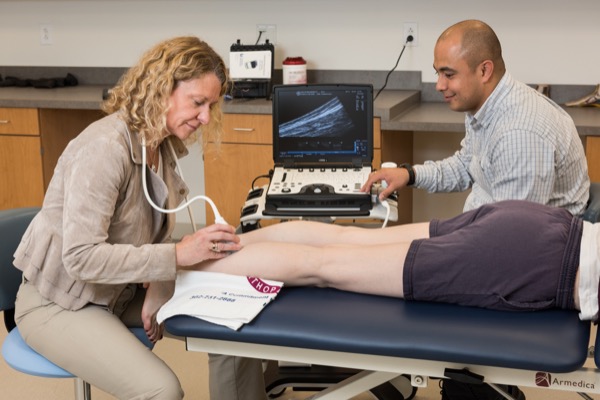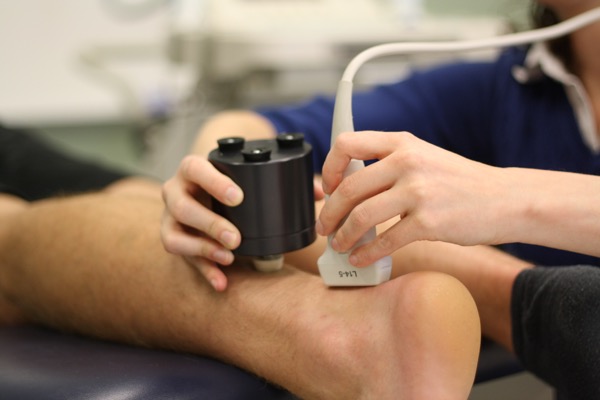


Achilles 'heal'
Physical therapy researcher goes on offense against Achilles tendon injuries
9:47 a.m., Jan. 22, 2016--POP! For athletes, the sound of an Achilles tendon rupture is one of the scariest sounds they’ll ever hear. It isn’t just another sports injury. An Achilles injury is often thought of as an athletics death sentence.
Connecting the back of the calf to the heel, the tendon is extremely important for movement. Many athletes worry that sprinting, jumping, or any kind of explosive activity will never be the same.
Research Stories
Chronic wounds
Prof. Heck's legacy
Whether it’s a complete or partial tear, tendinopathy or tendonitis, University of Delaware researcher Karin Silbernagel can help.
Silbernagel, an associate professor of physical therapy in the College of Health Sciences, was recently awarded two grants — the first from the Foundation for Physical Therapy and the second from the Delaware Biotechnology Institute — to dive deeper into these injuries. Her research team is already recruiting research participants for an observational study on tendon recovery.
“Like its Greek hero namesake, the Achilles is very strong and can tolerate a lot, but it’s certainly not indestructible,” Silbernagel said.
But, despite its claim to fame as the largest tendon in the body, the Achilles is one of the most commonly injured tendons. The injury garnered international attention in April 2013 when NBA star Kobe Bryant ruptured his left Achilles. While he eventually returned from the injury, it emphatically signaled the twilight of his storied career.
Achilles tendon injuries are not contained to the hardwood – any activity that demands running and jumping is on the list, including football, soccer, badminton, dancing and CrossFit. And the injuries come as a shock.
“Everybody looks behind them thinking, ‘What just happened?’ And then they can’t move. People experience a lot of immediate pain,” Silbernagel said.
While some people like Bryant go through rehabilitation and head back out on the court, others are never able to lace up their sneakers or cleats again. And that’s the big puzzle that Silbernagel is hoping to piece together: Why is there such a large variation in recovery outcomes? What differs between patients who do really well and those who don’t?
“Some patients recover 100 percent, so it is possible,” she said. “But I want to figure out how to get everybody to full recovery.”
The injury often occurs during a quick movement when the foot is put into dorsiflexion and the body is over top. Injury complications include gait abnormalities, strength deficits, and the tendon healing too long, which causes a problem with function.
When it comes to post-injury recovery, early “loading” and early mobilization of the tendon seems to be important, but Silbernagel stresses that a patient can’t overdo it and risk complications or re-rupture.
“You can think of a rupture like playing with Play-Doh,” she said. “If you pull on one side, you stretch it out. If you pull quickly on both sides, you snap it.”
So who is most at risk? The highest incidence rates are among men between the ages of 35 and 55. There is also an increasing incidence rate is women. And, yes, the great majority are sports-related.
People likely know someone who is the poster child for this injury. Guys who jump back into sports after a layoff. Maybe overweight. Maybe not as strong as before. They don’t get a chance to work out during the week, becoming “weekend warrior” athletes. They’re playing recreational or adult league sports and then, pop, they hear that gruesome, haunting sound.
“When you talk about the importance of physical therapy for adults, all of us want to be active and not have a fear for major injuries,” Silbernagel said.
Unfortunately, people who rupture the tendon rarely have symptoms beforehand. But, for those who find themselves in this age group, there is a recipe for injury prevention. In addition to range of motion exercises and allowing proper time for recovery, it includes focusing on the calf, which Silbernagel calls the “forgotten muscle.”
People from many states away have come to the Delaware PT Clinic to participate in UD physical therapy studies. Two to three new patients per week come the Science, Technology and Advanced Research (STAR) Campus site with Achilles-related injuries.
In Silbernagel’s upcoming study, participants will receive Fitbits to see how active they are during those early, crucial months for recovery. Since protecting the rupture sites are so important, the researchers will look at the mechanical properties of the tendon through elastography, which maps the elastic properties of soft tissue. The tendon is “vibrated” and then studied through ultrasound.
Over the course of time, the researchers want to see how those properties relate to recovery.
The big difference in Silbernagel’s work is she is hyper focused on the first 8 to 12 weeks after the injury, a crucial period for tendon healing.
“If we can identify which changes in mechanical properties is an indication of who does well or not, then we don’t have to wait six months to a year [post-injury] to do studies anymore,” she said. “If the activity level has anything to do with it, then we as physical therapists could be a lot more proactive early on.”
Research study recruiting
The Delaware Rehabilitation Institute at the University of Delaware is currently recruiting for multiple research studies. Visit udel.edu/dri/recruit to learn more.
Article by Dante LaPenta
Photos by Evan Krape and courtesy of the College of Health Sciences









